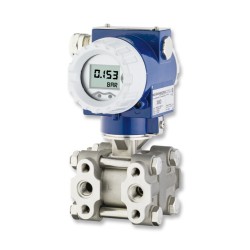 Rangeable describes a type of measurement instrument that has an output signal which can be adjusted by the operator to a different scaling.
Rangeable describes a type of measurement instrument that has an output signal which can be adjusted by the operator to a different scaling.
A rangeable instrument can be rescaled by adjusting the zero and span setting to a measurement between zero and the 100% full scale range of the instrument.
The different methods used to re-range a measurement instrument output include externally accessible variable potentiometers, push button controls or digital communications.
Some rangeable instruments have a limit on how much the scale can be reduced, which is typically expressed as a ratio of the maximum full scale. For example a 10 bar range pressure transmitter which can be reduced by up to 80%, would be described as having a 5 to 1 turndown ratio.
Often the accuracy performance will be compromised when a range is re-scaled to a reduced span, particularly with analogue based devices.
Some digital rangeable devices will offer a fixed percent of full scale accuracy to a certain level of turndown, beyond which the percent full scale accuracy will typically increase pro-rata.
 DPS300 User Switchable Pressure Range, Volts or Current Output Low DP Sensor - The DPS 300 is a low range HVAC differential pressure sensor. The lowest possible pressure range is 0...100 pascals. 2 or 3 switchable pressure ranges, plus volts or current output are included with most standard configurations.
DPS300 User Switchable Pressure Range, Volts or Current Output Low DP Sensor - The DPS 300 is a low range HVAC differential pressure sensor. The lowest possible pressure range is 0...100 pascals. 2 or 3 switchable pressure ranges, plus volts or current output are included with most standard configurations.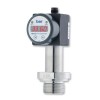 DS200P Sanitary Low Range Pressure Gauge, Switch and Sensor - All in one electronic switch, gauge and sensor designed specifically for use in the food, drink and biomedical industry for measuring process pressures.
DS200P Sanitary Low Range Pressure Gauge, Switch and Sensor - All in one electronic switch, gauge and sensor designed specifically for use in the food, drink and biomedical industry for measuring process pressures.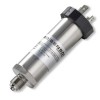 DMP331i High Accuracy Pressure Transmitter - High precision pressure transmitter with an accuracy of 0.1%FS BSL NLHR and digitally adjustable pressure ranges from 400mb up to 40 bar gauge & absolute.
DMP331i High Accuracy Pressure Transmitter - High precision pressure transmitter with an accuracy of 0.1%FS BSL NLHR and digitally adjustable pressure ranges from 400mb up to 40 bar gauge & absolute. DPT200 Pressurised Tank Level Differential Pressure Transmitter - Pressurised tank liquid level differential pressure cell transmitter for process plant storage.
DPT200 Pressurised Tank Level Differential Pressure Transmitter - Pressurised tank liquid level differential pressure cell transmitter for process plant storage. DPT200 High One Side Overload Differential Pressure Sensor - DP transmitter for measuring pressure difference between two pressure points which can tolerate up a very high overload pressure independently on either the positive or negative side port or both together at the same time.
DPT200 High One Side Overload Differential Pressure Sensor - DP transmitter for measuring pressure difference between two pressure points which can tolerate up a very high overload pressure independently on either the positive or negative side port or both together at the same time.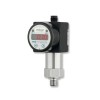 DS210 Combined Low Pressure Switch, Indicator and Sensor - Low range three in one pressure switch, pressure indicator and pressure sensor for use on pneumatics and HVAC applications.
DS210 Combined Low Pressure Switch, Indicator and Sensor - Low range three in one pressure switch, pressure indicator and pressure sensor for use on pneumatics and HVAC applications.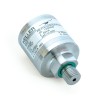 41X High Precision Low Range Pressure Transmitter - High precision pressure transmitter for measuring very low vented gauge reference or differential air pressures. Rangeable 4-20mA or 0-10 volt output.
41X High Precision Low Range Pressure Transmitter - High precision pressure transmitter for measuring very low vented gauge reference or differential air pressures. Rangeable 4-20mA or 0-10 volt output.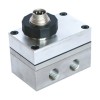 PD39X High Differential Pressure Transmitter - High pressure differential sensor with high over-pressure in scaleable differential ranges from 3 bar up to 300 bar differential.
PD39X High Differential Pressure Transmitter - High pressure differential sensor with high over-pressure in scaleable differential ranges from 3 bar up to 300 bar differential. PD39X Twin Absolute Digital DP Sensor - Digital pressure sensor with 3 separate channels for measuring P1, P2 and DP readings plus 2 temperature channels.
PD39X Twin Absolute Digital DP Sensor - Digital pressure sensor with 3 separate channels for measuring P1, P2 and DP readings plus 2 temperature channels.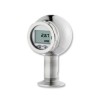 x|act i Rangeable Flush Pressure Transmitter with LCD Readout - Rangeable Pressure Transmitter with a hygienic all stainless steel construction with LCD digital readout display and optional HART communications.
x|act i Rangeable Flush Pressure Transmitter with LCD Readout - Rangeable Pressure Transmitter with a hygienic all stainless steel construction with LCD digital readout display and optional HART communications.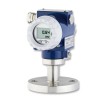 XMPi Process Plant Gauge and Absolute Pressure Transmitter - Process transmitter for measuring vacuum, steam, food, pharmaceutical, oil, gas and other pressure readings necessary for the monitoring and control of bulk production processes.
XMPi Process Plant Gauge and Absolute Pressure Transmitter - Process transmitter for measuring vacuum, steam, food, pharmaceutical, oil, gas and other pressure readings necessary for the monitoring and control of bulk production processes.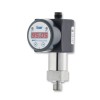 DS200 Combined Pressure Switch, Gauge and Sensor - Three in one electronic pressure switch, digital pressure gauge and pressure sensor with pressure ranges from 100 mbar up to 600 bar (1.5 to 9000 psi).
DS200 Combined Pressure Switch, Gauge and Sensor - Three in one electronic pressure switch, digital pressure gauge and pressure sensor with pressure ranges from 100 mbar up to 600 bar (1.5 to 9000 psi).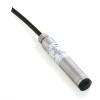 36XW Digital Submersible Hydrostatic Level Sensor - The 36 X W is a high accuracy sensor with analogue 4-20mA / 0-10Vdc or digital RS485 output for submersing into a liquid to measure depth.
36XW Digital Submersible Hydrostatic Level Sensor - The 36 X W is a high accuracy sensor with analogue 4-20mA / 0-10Vdc or digital RS485 output for submersing into a liquid to measure depth.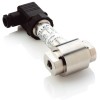 PD33X High Accuracy Differential Pressure Transmitter - High precision compact wet wet differential pressure transmitter with digitally corrected output signal in ranges from 0.3 to 30 bar
PD33X High Accuracy Differential Pressure Transmitter - High precision compact wet wet differential pressure transmitter with digitally corrected output signal in ranges from 0.3 to 30 bar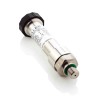 33X High Accuracy Digital Output Pressure Sensor - High precision pressure transducer with an accuracy of 0.05% full scale with a RS485, USB or RS232 digital interface for connecting to a PC.
33X High Accuracy Digital Output Pressure Sensor - High precision pressure transducer with an accuracy of 0.05% full scale with a RS485, USB or RS232 digital interface for connecting to a PC. PD33X Digital Differential Pressure Sensor - High precision differential pressure transducer with accuracy of 0.1% full scale. Available with RS485, USB or RS232 for connecting to a computer.
PD33X Digital Differential Pressure Sensor - High precision differential pressure transducer with accuracy of 0.1% full scale. Available with RS485, USB or RS232 for connecting to a computer.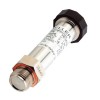 35X Flush Diaphragm Digital Output Pressure Sensor - Highly accurate digitally compensated pressure transducer with G1/2 male flush pressure port.
35X Flush Diaphragm Digital Output Pressure Sensor - Highly accurate digitally compensated pressure transducer with G1/2 male flush pressure port.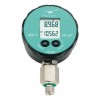 LEO3 Current or Digital Output Pressure Gauge - LCD digital pressure gauge powered externally by a 2 wire series 4-20mA current loop or a digital interface.
LEO3 Current or Digital Output Pressure Gauge - LCD digital pressure gauge powered externally by a 2 wire series 4-20mA current loop or a digital interface. DMP333i Rangeable High Pressure Precision Transducer - High performance transducer with adjustable scaling for modifying the pressure range for different applications. Ranges from 0-60 bar up to 0-600 bar.
DMP333i Rangeable High Pressure Precision Transducer - High performance transducer with adjustable scaling for modifying the pressure range for different applications. Ranges from 0-60 bar up to 0-600 bar.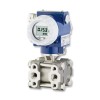 XMD Process Plant DP Cell Differential Pressure Transmitter - Rangeable DP Cell current loop process transmitter for monitoring differential pressures in a heavy duty process plant environment.
XMD Process Plant DP Cell Differential Pressure Transmitter - Rangeable DP Cell current loop process transmitter for monitoring differential pressures in a heavy duty process plant environment.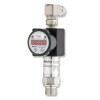 DS201P High Range Flush Pressure Gauge, Switch and Sensor - High pressure sensor, electronic switch and digital gauge with an all welded stainless steel flush diaphragm for high viscosity liquids.
DS201P High Range Flush Pressure Gauge, Switch and Sensor - High pressure sensor, electronic switch and digital gauge with an all welded stainless steel flush diaphragm for high viscosity liquids.
Help
Turn down accuracy
For a rangeable transmitter of lets say 100 bar g full scale, and a 100:1 turn down with an accuracy of 0.1%FS, the error would be +/-100 mbar over the range of 0 to 100 bar g. What would be the accuracy if it was re-ranged to 60 bar. Would it be +/-100mbar or +/-60mbar?
It will depend on the make and type, since some will improve the accuracy at lower ranges by using a % of reading method. The worse case error should be within 100 mbar at any point or range. You should be able to find some statement on the product data sheet explaining how the accuracy is affected by turndown.
